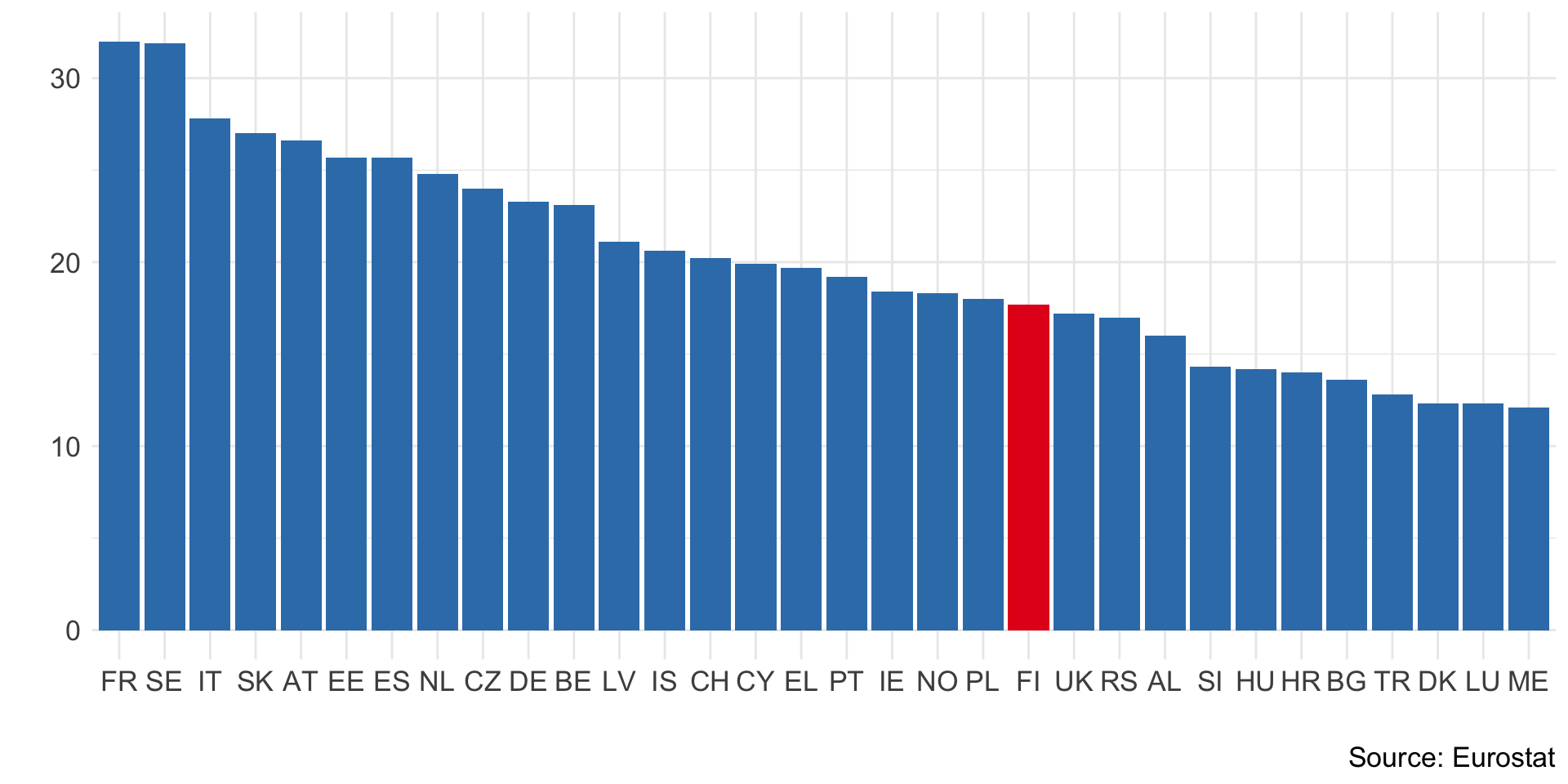
3. Labour Demand
KAT.TAL.322 Advanced Course in Labour Economics
March 13, 2024
Labour demand
Firm decisions about how much labour to hire.
Static model
Static model
Single factor input
Production function Y=F(L) where F′>0 and F′′<0
maxLPF(L)−WL
FOC: F′(L)=WP
Downward-sloping labour demand ∂L∂W=1PF′′(L)<0
Static model
Two factor inputs: conditional factor demand
Cost minimization problem
minL,KC(L,K)=WL+RK s.t. F(L,K)=ˉY
Conditional demand functions ˉK(W,R,Y) and ˉL(W,R,Y)
FL(ˉL,ˉK)FK(ˉL,ˉK)=WRandF(ˉL,ˉK)=ˉY
Static model
Two factor inputs: conditional demand elasticities
Own-price elasticities: ηLW=∂lnˉL∂lnW<0, ηKR=∂lnˉK∂lnR<0
Cross-price elasticities: ηLR=∂lnˉL∂lnR>0 and ηKW=∂lnˉK∂lnW>0
Elasticity of substitution σ=∂ln(KL)∂ln(WR)>0
It is also possible to show that
ηLR=σ(1−s)andηLW=−σ(1−s)
where s=WLC is labour share in total cost
Static model
Two factor inputs: unconditional factor demand
maxYPY−C(W,R,Y)
Solution: P=CY(W,R,Y∗),L∗=ˉL(W,R,Y∗),K∗=ˉK(W,R,Y∗)
Total elasticities decomposed into substitution and scale effects:
εLW=ηLW+ηLYεYW<0
εLR=ηLR+ηLYεYR≶0
Estimations of static model
Empirical strategy
Shephard’s lemma: specify cost function and back out labour demand
Example: translog cost function with n inputs
lnC=a0+n∑i=1ailnWi+12n∑i=1n∑j=1aijlnWilnWj+1θlnY
⇒si=ai+n∑j=1aijlnWj
Estimate parameters ai,aij and calculate implied elasticities.
Estimations of static model
Main issues
Endogeneity
General equilibrium
Definitions of variables
Estimations of static model
Review by Hamermesh (1996) concludes that −ηLW∈[0.15,0.75].
If ηLW=−0.30 and given that s≈0.7,
σ=−ηLW1−s≈1
consistent with the Cobb-Douglas production function.
The review also suggests −εLW≈1⇒ large scale effect.
Dynamic model
Dynamic model
Adjustment costs
Quadratic cost: C(ΔLt)=b(ΔLt−a)2
Assymmetric convex costs: C(ΔLt)=−1+eaΔLt−aΔLt+b2(ΔLt)2
Linear cost: C(ΔLt)={chΔLtif ΔLt≥0−cfΔLtif ΔLt≤0
Fixed cost
Dynamic model
Quadratic adjustment cost
Continuous time ⇒ΔLt=˙Lt=dLtdt
Π0=∫∞0Πtdt=∫∞0[F(Lt)−WtLt−b2˙L2t]e−rtdt
Euler equation: ∂Πt∂L=ddt(∂Πt∂˙Lt)⇒b¨Lt−rb˙Lt+F′(Lt)−Wt=0
Dynamic model
Quadratic adjustment cost
Optimal path: ˙Lt=γ[L∗−Lt] where γ is decreasing in b.

Figure 9.6 Optimal employment over a cycle (Nickell 1986)
Dynamic model
Linear adjustment cost
Π0=∫∞0[F(Lt)−WtLt−C(˙Lt)]e−rtdt
where C(˙Lt)={ch˙Ltif ˙Lt≥0−cf˙Ltif ˙Lt≤0
Optimal labour demand path is derived from
{F′(Lt)=Wt+rchif ˙Lt≥0F′(Lt)=Wt−rcfif ˙Lt<0
Dynamic model
Linear adjustment cost

Figure 9.10 Optimal employment over the cycle (Nickell 1986)
Estimations of dynamic model
Empirical strategy for adjustment cost specification
Quadratic adjustment cost
Assume linear quadratic production function
Estimate Lit=λLi,t−1+Xitβ+μi+εit
- accounting for correlation between Li,t−1 and μi+εit
Other adjustment costs and production functions
Estimate Euler equation directly
Current employment Lt depends on past and future variables
Appropriate econometric methods (Hamilton 1994 book)
Estimations of dynamic model
Some key results
Adjustments happen fast (1-2 quarters) (Hamermesh 1996, chap. 7)
Dynamic substitutes: utilization of capital increases with Lt−L∗
Hours of work are adjusted faster than number of workers
![]()
Figure 1 from Houseman and Abraham (1993) (adjustment to demand shocks)
Minimum wages and employment
Minimum wage and employment
What do the models we have considered so far predict?
lower labour demand (both compensated and uncompensated)
(maybe) higher labour supply
Any “problems” with these conclusions?
Typically not supported by empirical evidence!
Minimum wage and employment
Card and Krueger (1994)
It stayed at $4.25 in Pennsylvania.

Minimum wage and employment
Card and Krueger (1994): Difference-in-differences
- Compare before and after:
ENJt1−ENJt0 = 0.59 (se = 0.54)
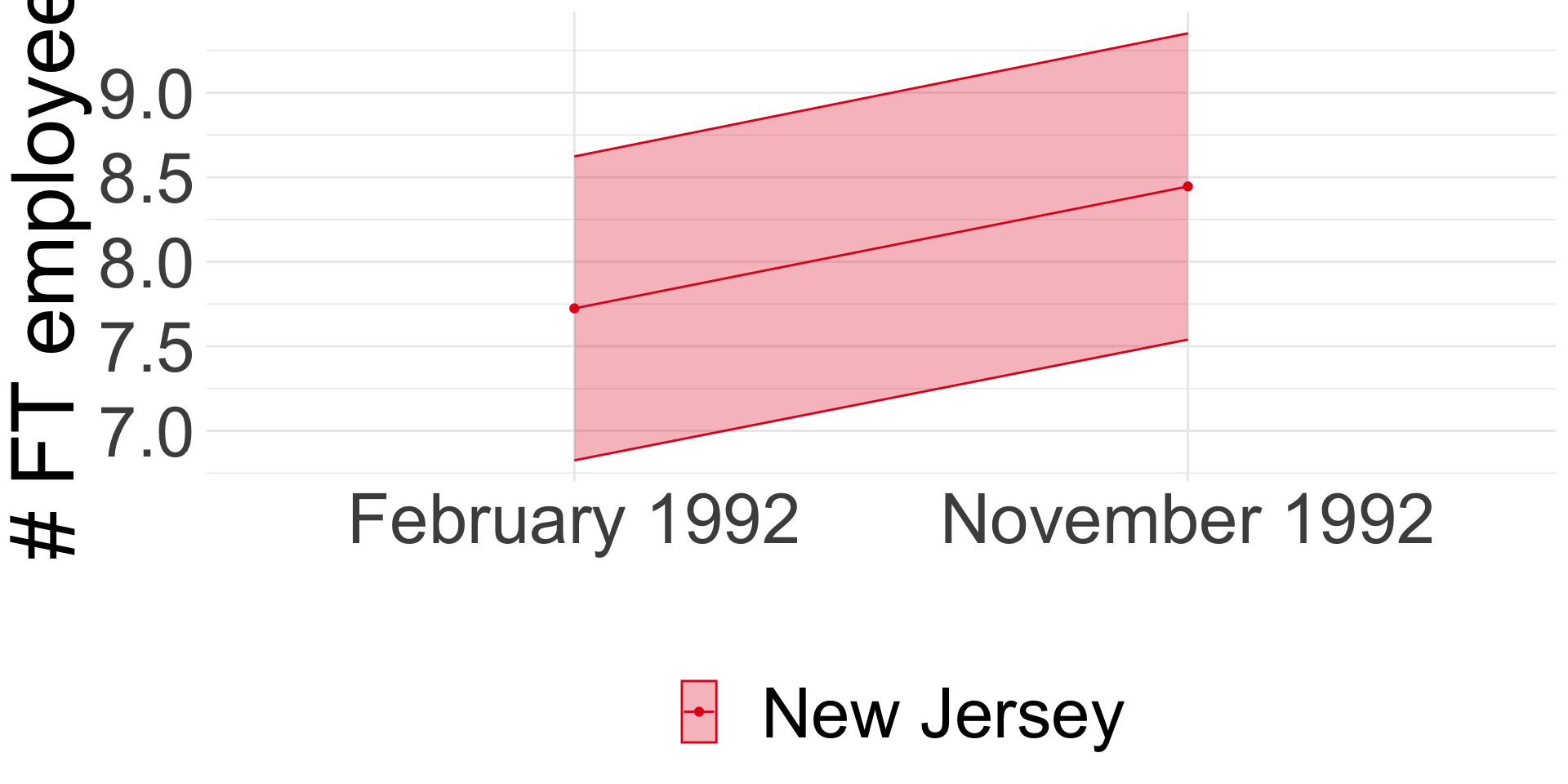
Minimum wage and employment
Card and Krueger (1994): Difference-in-differences
- Compare before and after:
ENJt1−ENJt0 = 0.59 (se = 0.54) - Compare NJ and PA:
ENJt−EPAt = -2.89 (se = 1.44)
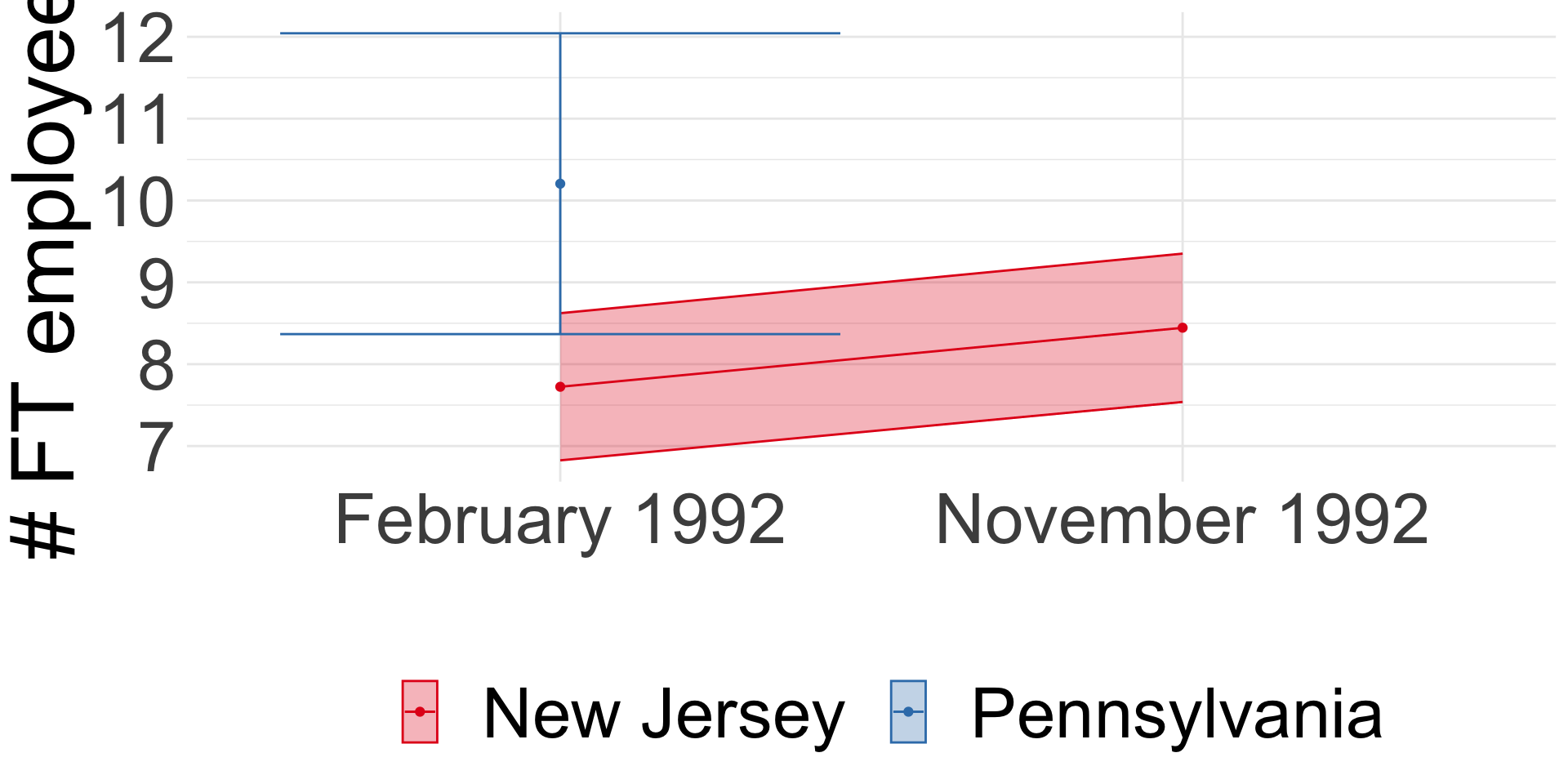
Minimum wage and employment
Card and Krueger (1994): Difference-in-differences
- Compare before and after:
ENJt1−ENJt0 = 0.59 (se = 0.54) - Compare NJ and PA:
ENJt−EPAt = -2.89 (se = 1.44) - Diff-in-diff:
(ENJt1−ENJt0)−(EPAt1−EPAt0) = 2.75 (se = 1.34)
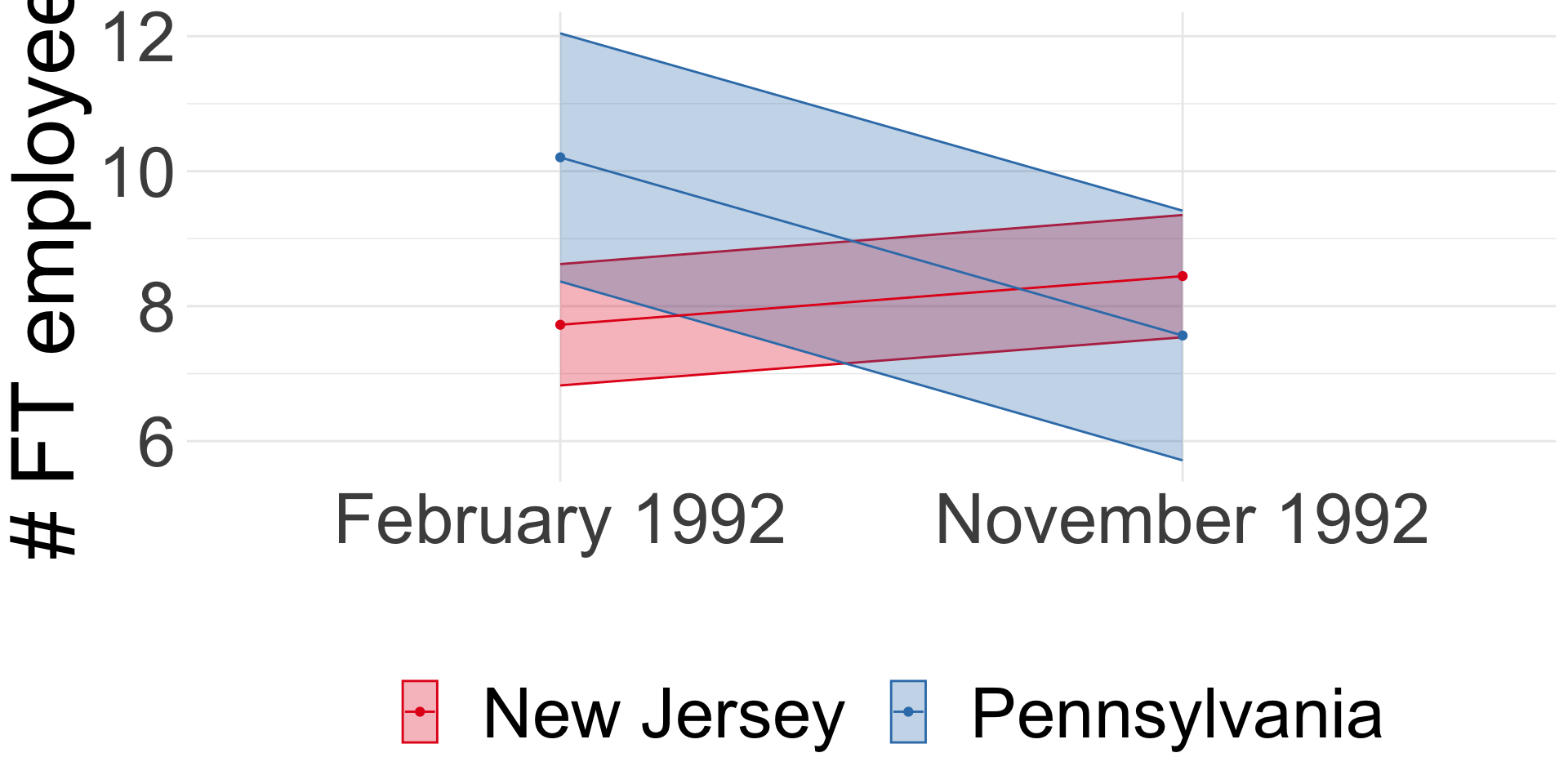
Minimum wage and employment
Jardim et al. (2022)
Seattle ↑ min wage from $9.47 up to
- $11 in April 2015
- $13 in January 2016
Causal design:
- synthetic control: weighted average of other counties that match pre-Seattle
- nearest neighbour matching: find “closest” worker outside of Seattle matching treated worker in Seattle
Minimum wage and employment
Jardim et al. (2022): synthetic control
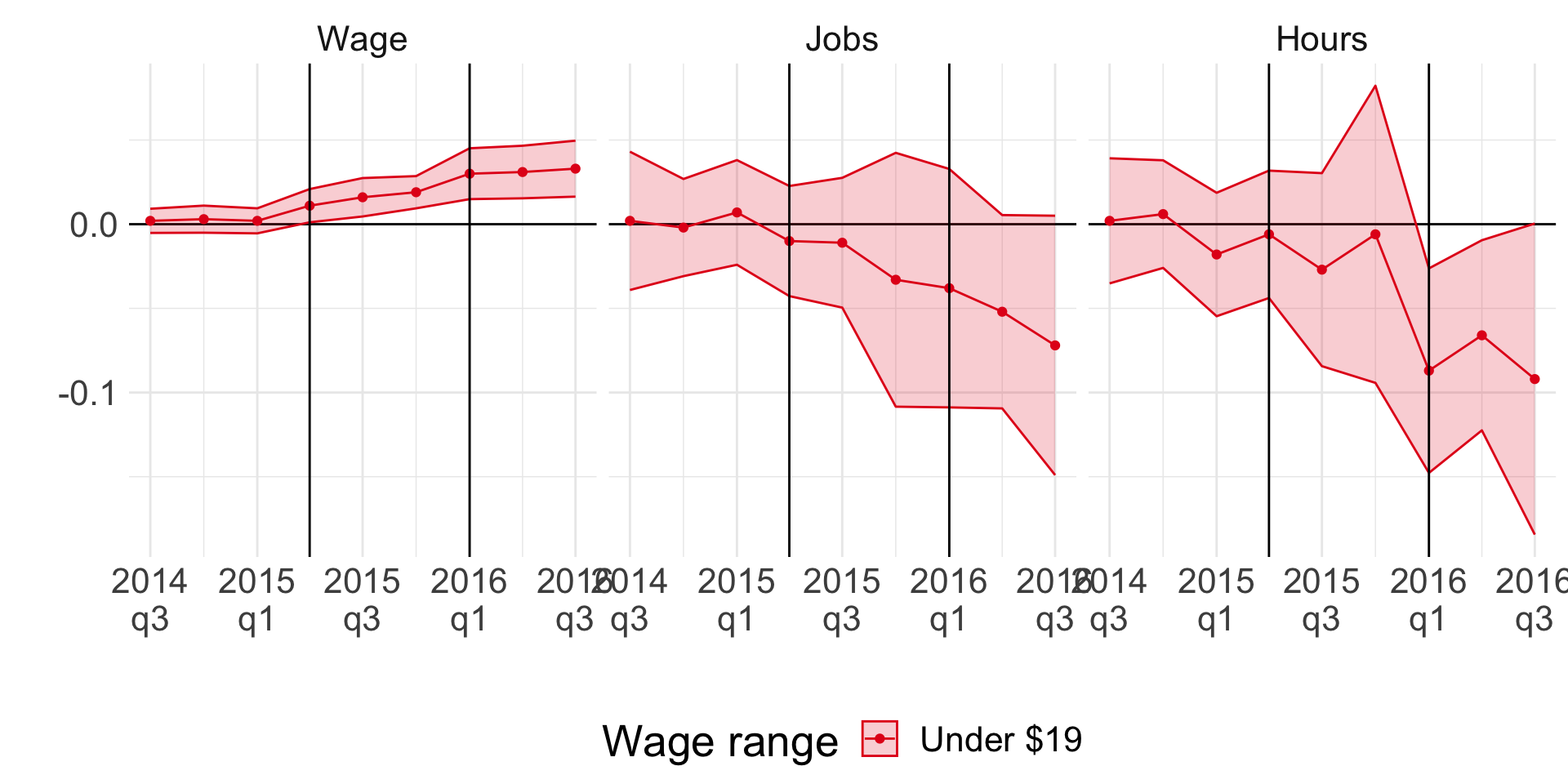
Minimum wage and employment
Jardim et al. (2022): synthetic control
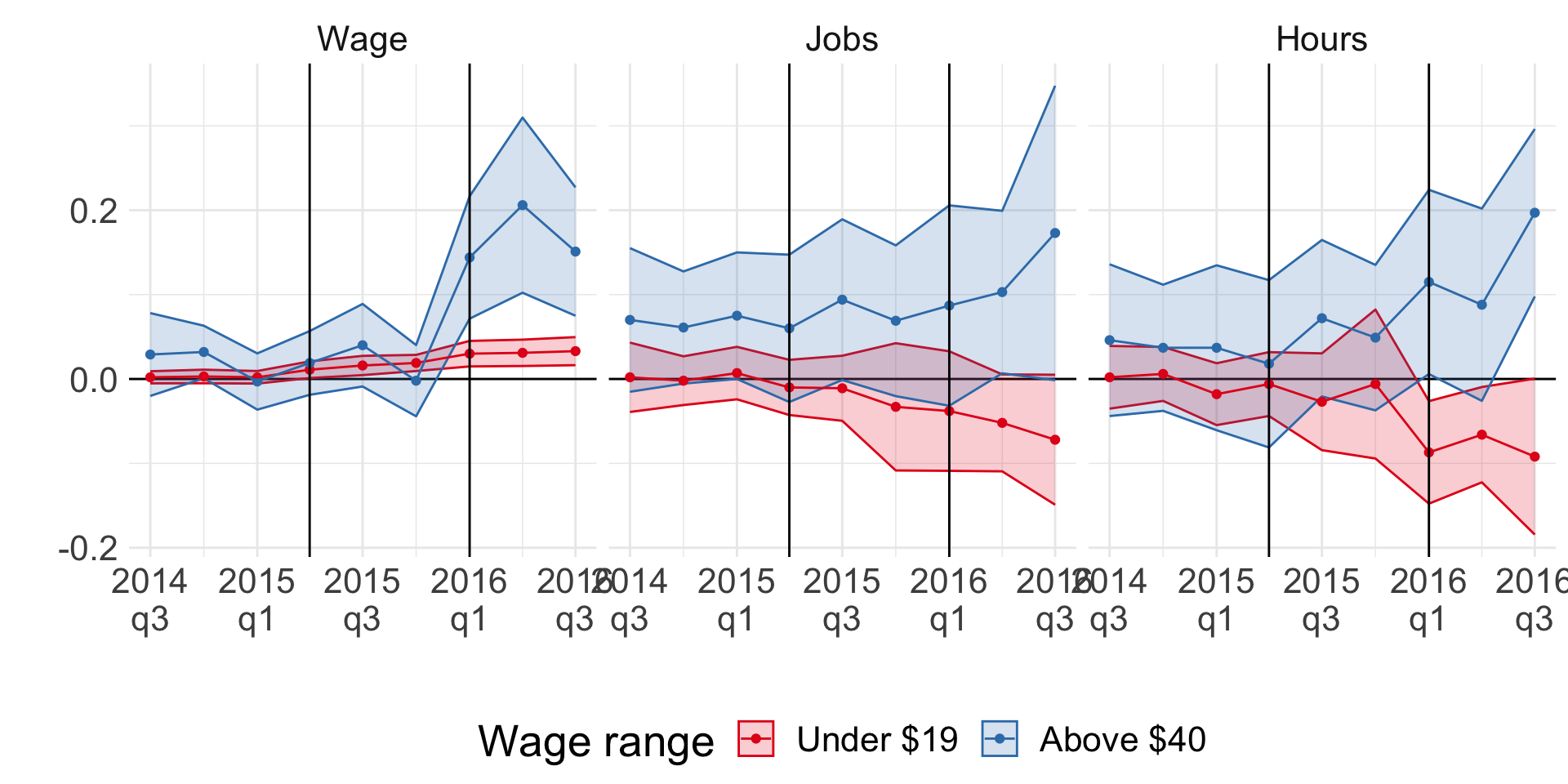
Minimum wage and employment
Jardim et al. (2022)
- Negative effect on hours worked stronger than on employment
- Experienced workers are better off
However,
- Potentially cascading effect
- Excluded large low-wage employers (like McDonald’s) (monopsony)
Reich, Allegretto, and Goddy (2017)
same policy + synthetic control = no change in employment
Minimum wage and employment
Monopsony
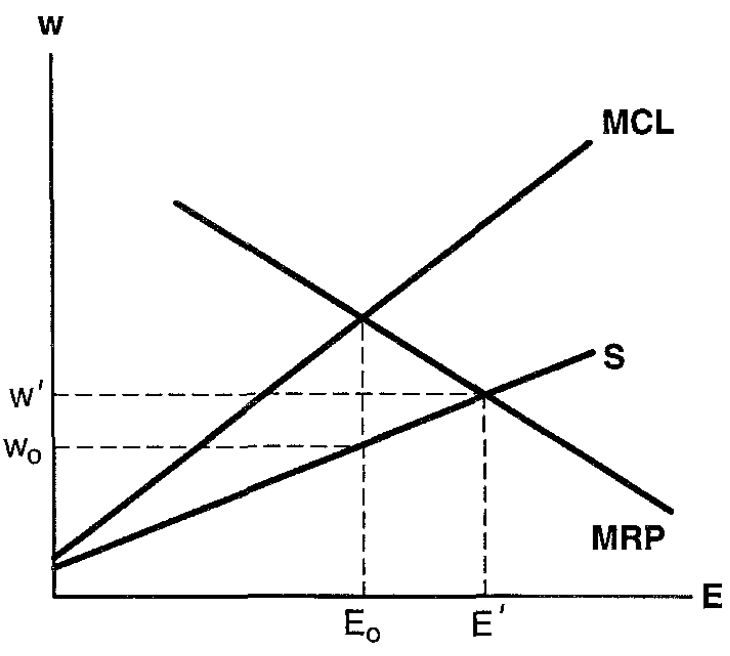
Source: Figure 3 from Brown (1999)
Minimum wage and other margins
Review in Clemens (2021)
- Price pass-through (Leung 2021; Renkin, Montialoux, and Siegenthaler 2022)
- Non-wage labour cost (Clemens, Kahn, and Meer 2018)
- Flexibility (theoretical Clemens and Strain 2020)
- Effort (Ku 2022; Coviello, Deserranno, and Persico 2022)
- Firm profit (Draca, Machin, and Van Reenen 2011; Bell and Machin 2018)
- Firm exit (Luca and Luca 2019; Dustmann et al. 2022)
Summary
Basic static and dynamic models of labour demand
Application to minimum wage policy
- Ongoing research (little consensus)
- Clear that basic models are insufficient
- Typical frameworks: heterogeneous labour, monopsony
- Non-wage margins important and can interact with labour supply
Next: Human Capital
References

